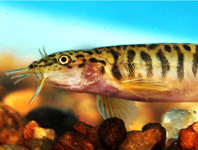Abstract
In this article we report on a hexactinellid sponge new to science, Tretopleura weijicus sp. nov., which was collected from the Weijia Seamount in the northwestern Pacific Ocean at a depth of 1995 m. Its blade-like and branching body form, the primary choanosomal framework consisting of multiaxial longitudinal strands without synapticula, and the presence of sceptrules suggest placement within the family Uncinateridae Reiswig, 2002, which is also supported by molecular phylogenetic evidence from COI and 16S sequences. The absence of swollen dermal spurs or regular pentactins and the presence of two types of discohexasters characterize it as a new species. More specimens should be collected to revise the generic characters.
References
Dohrmann, M. (2019) Progress in glass sponge phylogenetics: a commnet on Kersken et al. (2018). Hydrobiologia, 843, 51–59.
https://doi.org/10.1007/s10750-018-3708-7
Dohrmann, M., Janussen, D., Reitner, J., Collins, A.G. & Wörheide, G. (2008) Phylogeny and evolution of glass sponges (Porifera, Hexactinellida). Systematic Biology, 57, 388–405.
https://doi.org/10.1080/10635150802161088
Dohrmann, M., Kelley, C., Kelly, M., Pisera, A., Hooper, J.N.A. & Reiswig, H.M. (2017) An integrative systematic framework helps to reconstruct skeletal evolution of glass sponges (Porifera, Hexactinellida). Frontiers in Zoology, 14, 18.
https://doi.org/10.1186/s12983-017-0191-3
Folmer, O., Black, M., Hoeh, W., Lutz, R. & Vrijenhoek, R. (1994) DNA primers for amplification of mitochondrial cytochrome c oxidase subunit I from diverse metazoan invertebrates. Molecular Marine Biology and Biotechnology, 3, 294–299.
Ijima, I. (1927) The Hexactinellida of the Siboga Expedition. In: Weber, M. (Ed.), Siboga-Expeditie. Uitkomsten op zoologisch, botanisch, oceanographisch en geologisch gebied verzameld in Nederlandsch Oost-lndië 1899-1900 aan boord H.M. ‘Siboga' onder commando van Luitenant ter zee 1e kl. G.F. Tydemann. 106 Monographie VI. E.J. Brill, Leiden, pp. i–viii + 1–383, pls. I–XXVI.
Kearse, M., Moir, R., Wilson, A., Stones-Havas, S., Cheung, M., Sturrock, S., Buxton, S., Copper, A., Markowitz, S., Duran, C., Thierer, T., Ashton, B., Meintjes, P. & Drummond, A. (2012) Geneious Basic: An integrated and extendable desktop software platform for the organization and analysis of sequence data. Bioinformatics, 28 (12), 1647–1649.
https://doi.org/10.1093/bioinformatics/bts199
Lanave, C., Preparata, G., Saccone, C. & Serio, G. (1984) A new method for calculating evolutionary substitution rates. Journal of Molecular Evolution, 20, 86–93.
https://doi.org/10.1007/BF02101990
Larkin, M.A., Blackshields, G., Brown, N.P., Chenna, R., McGettigan, P.A., McWilliam, H., Valentin, F., Wallace, I.M., Wilm, A., Lopez, R., Thompson, J.D., Gibson, T.J. & Higgins, D.G. (2007) Clustal W and Clustal X version 2.0. Bioinformatics, 23, 2947–2948.
https://doi.org/10.1093/bioinformatics/btm404
Rambaut, A. (2006) FigTree. Version 1.3.1. Computer software and manual. Available from: http://tree.bio.ed.ac.uk/software/figtree (accessed 6 October 2020)
Reiswig, H.M. (2002) Family Uncinateridae fam. nov. In: Hooper, J.N.A. & Van Soest, R.W.M. (Eds.), Systema Porifera: A Guide to the Classification of Sponges. Kluwer Academic/Plenum Publishers, New York, pp. 1372–1376.
https://doi.org/10.1007/978-1-4615-0747-5_141
Reiswig, H.M. & Kelly, M. (2011) The marine fauna of New Zealand: Hexasterophoran Glass Sponges of New Zealand (Porifera: Hexactinellida: Hexasterophora): Orders Hexactinosida, Aulocalycoida and Lychniscosida. NIWA Biodiversity Memoirs, 124, 1–176.
Stamatakis, A. (2014) RAxML version 8: a tool for phylogenetic analysis and post-analysis of large phylogenies. Bioinformatics, 30, 1312–1313.
https://doi.org/10.1093/bioinformatics/btu033
Tabachnick, K.R. (1988) Hexactinellid sponges from the mountains of the West Pacific. In: Shirshov, P.P. (Ed.), Structural and Functional Researches of the Marine Benthos. Academy of Sciences of the USSR, Moscow, pp. 49–64.
Yang, Z. (1994) Maximum likelihood phylogenetic estimation from DNA sequences with variable rates over sites: approximate methods. Journal of Molecular Evolution, 39, 306–314.
https://doi.org/10.1007/BF00160154
Silvestro, D. & Michalak, I. (2012) RaxmlGUI: a graphical front-end for RAxML. Organisms Diversity & Evolution, 12, 335–337.


